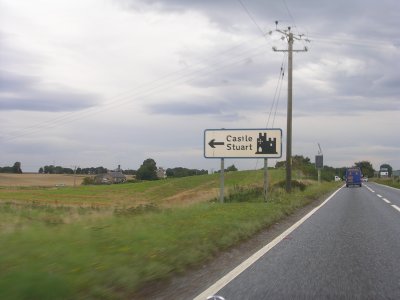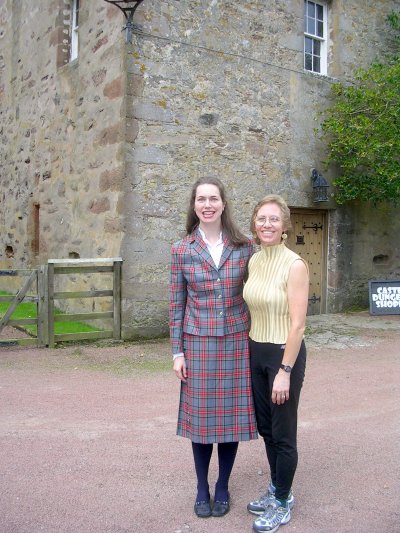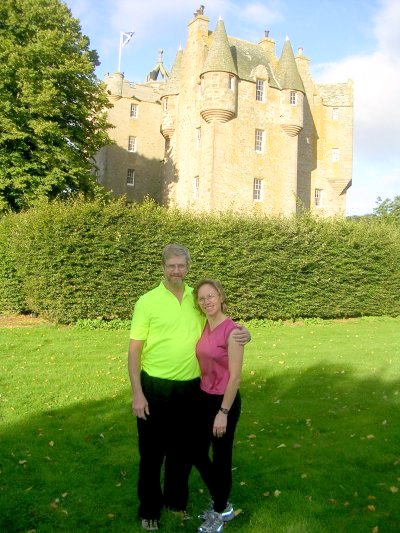| << | 11 |
Scotland Adventure, Page 4
Pictures and Stories About Bicycle Adventures
Scotland and England
By Bicycle, September, 2006


Above Left: The fishing village of Pittenweem, Scotland. Its hard to make a living fishing now. The weekly fish market isn't weekly anymore.
Above Right: Anstruther water front homes. Just up the road from Pittenweem. We bought a "smokie" for snack food (Smoked Haddock ).


Above Right: Anstruther harbor.


Above Left: Crab & Lobster Traps.
Above Right: Different Whale Harpoons.


Above Right: St Andrews, Old First Link.


Above Right: This is the chapel and location of the crownings. It is located across from the palace, or to the right side of the Scone Palace picture. A copy of the Stone of Scone is sitting to the bottom left side of the chapel picture. The site is said to have previously been a Celtic ceremonial ground with magical powers. The mound that the present chapel is on is said to be artificially built up from dirt carried in boots from lords who affirmed their loyalty to the king.
The Stone of Scone, itself is supposed to be of Celtic origins, with a history long lost. Kings are crowned while they are sitting on the Stone of Scone. The English took the Stone of Scone and placed it under the Royal Throne in London but the English returned it to Scotland just recently - also Scotland has just recently been allowed to govern itself with their own Parliament. There is a rumor that the Stone of Scone, that the English took, was not the real stone but a double and accordingly the real Stone of Scone is hidden and protected by a Secret Scottish Society that is awaiting their own Scottish King.
The Stone of Scone that the English took and returned is in a hermetically sealed and guarded vault that is on public display at Edinburgh Castle. Terry and I did see it and no pictures were allowed, the waiting line was long and inside the viewing room it was hot from so many people in such a small area - it may be deliberate to keep people moving.


Above Right: View of Scone Palace from the Gate.


Above Right: Scone Palace Peacock.


Above Right: The Palm Court, Aberdeen, Scotland. Our place to stay for the night. A Reception for a Scottish Wedding was held here and we were privileged to meet and see many of the attendees in their Tartans and Kilts.


 Day 12: Aberdeen, various Ancient Pict Sites, Elgin
Day 12: Aberdeen, various Ancient Pict Sites, Elgin
Above Left: Aberdeen, Union Terrace Walk.
Above Right: Old Aberdeen, Spital Walk.
The term Pict first appears in Roman literature, from the times of Roman occupation of England. Pic is the Roman (Latin) root word for "Paint," as in Picture. Picti is the Roman word for "people who paint themselves" in what is now known as Scotland. 'Pictograph' and 'Pictogram' are words that are also derived from Pic. Picts are the descendents of the native born iron age tribes of the same area.
Right: The Maiden Stone merges Pictish art, symbols, and stone carving skills with Christian symbols (on the other side). The stone is not weathering well and should already have been protected from rain.
Left or Above Left: Brandsbutt Pictish Stone contains a Pict V-Rod (upper 'V' symbol on inverse crescent) and a Z-Rod (lower Z [like a double 'L'] through a snake). So far as we know, the meanings are not known. The Pictish Symbols were consistently used in many sites across mid to northern Scotland. The Picts were firmly in place to be the enemy of Rome but they kind of died out as a culture with the continued emergence of Viking immigration and Christianity indoctrination to the area. Brandsbutt Pictish Stone is thought to have been erected between 500 and 1000 AD (or CE, Common Era). Interestingly, it has graffiti on it from about 1300 AD, a Viking rune which states "IRATADDOARENS" which is likely associated with "Eddarron," a version of Saint Ethernanus.
Next to the Pict stone (not pictured), there is a reconstructed Stone Circle (Henge) that dates back to 300 BC (BCE, Before Common Era). Little is known as the entire site was destroyed by a farmer who blew up all of the stones and used them to line an irrigation ditch. What we see here is the farmers reconstruction. We found this kind of attitude to be prevalent throughout Scotland. As it is, Brandsbutt Pictish Stone is in the middle of a residential suburb and it has no signage to lead one here. We had to ask locals for directions many times.


The building of a stone circle would have to be a community effort and could possibly have spanned more than one generation of contribution. Oddly, the circles and symbols are similar across the realm for their time periods, which implies a knowledge sharing process and/or knowledge openness.
Above Right: East Side view of the Loanhead of Daviot and its Recumbent Stone.


Above Right: Burghead Well is a covered cistern well. This is all that remains of a Viking city-fort on the peninsula of Burghead. We visited enough of the Viking establishments to know that most of them valued their water supply so much that none of them were left to the open sky. Since all Viking establishments are next to the ocean, well water seems to be within ten feet of depth and every well was lined with rock and had a rock arch or lintel roof and were covered in a ten foot or so dirt mound. Access was a short inclined rock lined tunnel.
We actually came to this location see some Pict carvings but they had been relocated to a museum in another city. Interestingly, Burghead Well was closed upon our arrival (unbeknownst to us), however when we stopped to ask for directions to the Well (two blocks away), the person that we stopped just happened to be the curator. He went back into his house and brought us the keys and asked us to leave the keys in the foyer of his house when we were through. Now that was kind, generous, and trusting on several levels!


Above Left: The Suenos Stone is located near Forres. This twenty foot tall stone is a better preserved because it is housed in a weather resistant glass housing. The stone dates to the ninth century and depicts a battle, but there are three different scenarios that fit for that time period, so the actual meaning is not known now.
Above Right: Pictured is two Whisky products from the Dallas Dhu distillery located not to far from Forres. Dallas is Gaelic for water and Dhu is Gaelic for Dark. Dallas Dhu is located between two pristine rivers and the better the water, the better the whisky. It is unknown what the 'Dhu' is in reference, but there are about forty distilleries within a fifteen mile radius (which says something for the water quality of the water in the area)


Above Right: The Worm Tub is where the distilled product condensates.


Above Right: In Scotland, the street light sequence goes from Green to Yellow & Red together (as pictured), and then to Red. Also the Red Light goes to Green and Yellow together and then to Green. We actually like the Scottish method better than the US mystery timing method, there you know what is coming whereas in the US you have to look at the other lane's lights if you can see them - the Scottish method just seems more helpful to drivers. Also, at night, that little Yellow pedestrian tower becomes luminescent which helps with night time driving safety.


Above Right: Jacobite Army Battle Memorial.


Above Right: One of the Official Loch Ness "Monster" Visitor Centers. There were some nice hiking trails in the area and we got to enjoy one of them.


Above Right: Castle Stuart from the rear (from the north side). The south side entrance is so forested that one cannot see much of the castle at all. We actually went on a hike to get this outstanding picture! Notice the architectural Crown of Royalty.
When we were on the walk, an elderly and polite gentleman asked Terry if she was having a good time at Castle Stuart - He also asked if she needed anything to help make her stay better. Terry explained that we were having a wonderful time and we were very happy with our stay. He drove off in a nondescript sedan. I commented that that was probably the Duke. Well, I was close, it was Charles Stuart.


Above Right: Dennis and Terry, the next morning - picture by Caroline.


Above Right: The Castle's Dinner Piper. Again, picture by Caroline.


Above: One of the many hidden doors or secret passageways and Terry.


Above Right: Bed Chambers. Terry and a Four Poster Bed in a Castle! We slept very well!